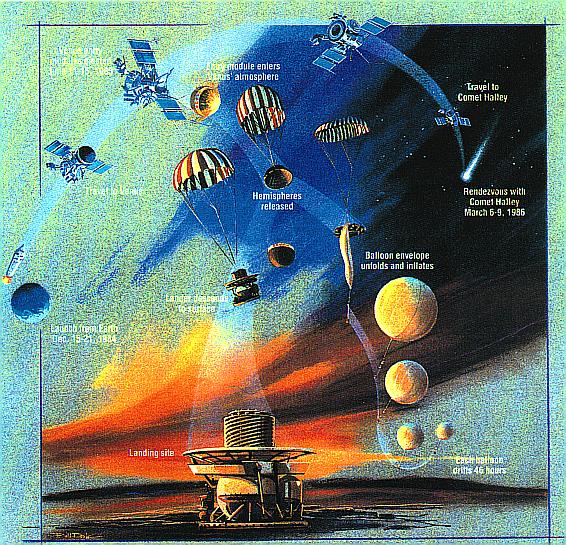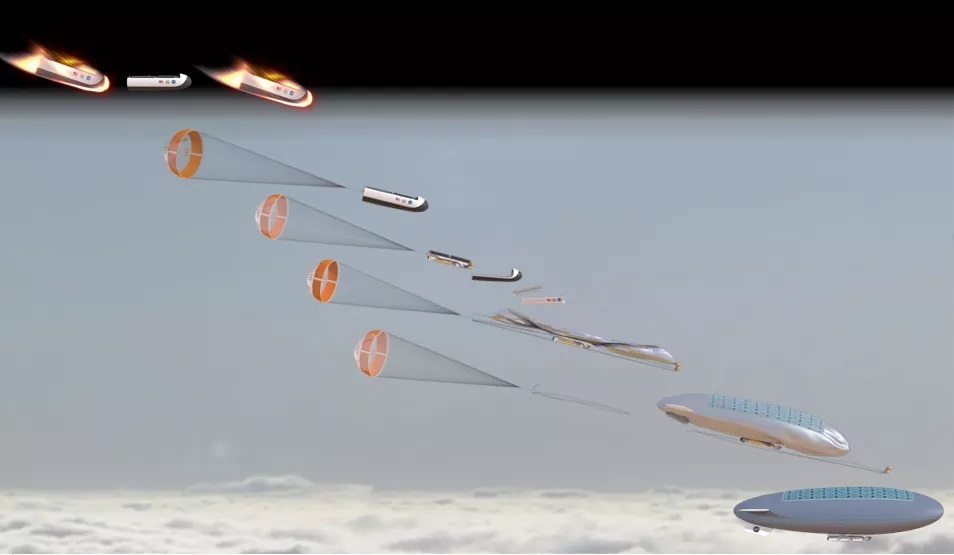The intention of sending space probes, in coming years, to Venus was announced by the American Agency NASA (DAVINCI+, VERITAS), the European ESA (EnVision) and UAE. The Russian Agency ROSKOSMOS has already been working on the preparation of their next mission to Venus called Wenera-D.
In the end of last year the race was joined by private explorers such as the MIT scientists (Massachusetts Institute of Technology) who are going to finalize on their own series of missions under the name Venus Life Finder.

Artistic vision of probing the atmosphere of Venus with balloons.
Author: Adrian Mann
Why shouldn't also Poland join with our own mission? The main reasons are always funds, the solution could be in Crowdfunding and contrary to appearances it does not have to be a costly project.
Why only her atmosphere, and not a surface lander right away?
Our neighbour planet is rather hostile… About the conditions there and the history of exploration you will find out more on the bookmark
Speaking directly: its surface reminds hell, but the clouds ..
At the height of 50 km in the atmosphere of Venus the temperature, pressure and insolation are similar to the ones offered by the Mediterranean resorts .. except, perhaps, wind which blows with the speed of 300 km/h, sulfuric acid rain, ubiquitous carbon dioxide instead of breathing air, but those are only minor inconveniences.
Any vehicle landing on the Surface of Venus is problematic which ensures sleepless nights to the best scientists in the biggest Universe agencies in the world. It is like a journey to the away at millions of kilometres Mariana Trench, full of destructive acid and heated to 500 degrees Celsius…
Therefore just an entry into the atmosphere of the planet is a task incomparably less complicated: no risk of collision with the Surface or any other object, relatively mild weather conditions, easier communication with the Earth and also dense sea of semi-liquid carbon dioxide in which an air inflated object could drift like a boat on water…
Not only it is impossible because it was realized twice as a secondary task almost 40 years ago during the Russian missions WeGa. However, considering dropping costs of space missions and the technological development it could be quite .. simple and cheap ..
Designing such a mission will cost about one Sousa* while realisation should be around one Sasin* 😉. In other words: we have spent much more but what can we gain if we succeed? Please read below!
*Paulo Sousa was a controversial former coach of the Polish National Football Team…
*Jacek Sasin – polish government official, responsible for spending large amount of budget.

Vega mission. NSSDC NASA PD image
Benefits from a realisation of such a mission as well as innovation which lie behind the project
The precise shape of a mission, especially the application of scientific tools, will be determined by a Project Team in cooperation with all Space agencies in order to maximize the scientific achievements of this project. Even at the present stage it is possible to indicate the exemplary and potential benefits:
It will be the first interplanetary mission bottom-up funded. After giving access to the Space to companies, the time has come to pave the route to public Space projects realised by countries with more modest budgets.
The realisation will bring the first visual images from the clouds of Venus to people. One picture is more precious than a thousand words. We will see what it is like out there!
We will promote the possibilities of the Polish cosmic sector and Polish universities in the way which is going to surprise the world.
Without the minority complex we will join the Space race in which everyone is a winner. Scientific data, which will be obtained, will be made public in order to help in future missions also to big agencies worldwide.
We have a chance to make the first in history controlled aerostat flight in the clouds of another planet. The priority palm for the first airship flight went to the small but courageous Martian helicopter called Ingenuity.
We will verify experimentally the effectiveness and buoyancy of such an object in the atmosphere of Venus which is going to help the future crew missions and even colonizing ones…

NASA High Altitude Venus Operational Concept ( HAVOC ) Courtessy of Advanced Concepts Lab at NASA Langley Research Center

Courtessy of Venus Labs. Artist: Josh Haberman
There are many, many more reasons to accomplish such a mission. However, let's keep one leg on the proverbial Earth and deal with the specifics. How can we achieve it all? Please read below!
Implementation phases
The whole project can be initially divided to the following phases:
Phase 0: Recognition and increasing public interests with such a mission and starting to collect funds for the Project design.
Phase 0.5: Recruitment of a Project manager who has suitable predispositions, knowledge and experience.
Phase 1: The beginning of the Project Team recruitment through commercial campaign on Polish universities and labour market. Equipment of positions.
Phase 2: Creating a number of Project concepts in cooperation with institutions and entities with similar aspirations. Preparation of an estimate of the concept selected for the implementation.
Phase 3: Designing the mission course.
Phase 3.5: Building and testing of the probe prototype. Specifying the final mission parameters after the experimental corrections as well as defining the time frames of the realisation.
Phase 4: Starting to collect funds for the mission accomplishment.
Phase 5: Realisation… 😉
